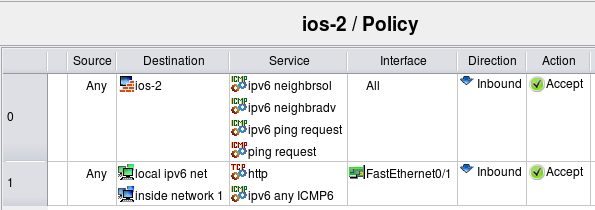Search Users Guide
Mixed IPv4/IPv6 rule sets can be especially useful in the configuration of the router's access lists and firewall policies where rules can become rather complicated when IPv6 is added to an existing IPv4 network. Since most firewalls and routers require different syntax for IPv6 ACL and rules, administrator has to implement second rule set for IPv6, carefully trying to copy existing IPv4 rules to preserve general structure and meaning of the security policy. Things get even more complicated after that because every change in the policy should now be reflected in two sets of ACL or firewall rules. Keeping these synchronized can quickly turn into major task that can significantly elevate probability of human error and network outage. Mixed IPv4+IPv6 rule sets in Firewall Builder help solve this problem.
Lets illustrate this using simplified example of a Cisco router access list configuration that we migrate from IPv4 only to mixed IPv4+IPv6. We start with simple two rules that use only IPv4 address and service objects:
In this example, the router has just two interfaces, FastEthernet0/0 and FastEthernet0/1, both interfaces have only IPv4 addresses when we start. The generated configuration looks like this:
! ================ IPv4
! Policy compiler errors and warnings:
!
no ip access-list extended fe0_0_in
no ip access-list extended fe0_1_in
ip access-list extended fe0_0_in
permit icmp any host 192.0.2.1 8
permit icmp any host 192.168.1.1 8
exit
ip access-list extended fe0_1_in
permit icmp any host 192.0.2.1 8
permit icmp any host 192.168.1.1 8
permit tcp any 192.168.1.0 0.0.0.255 eq 80
exit
interface FastEthernet0/0
ip access-group fe0_0_in in
exit
interface FastEthernet0/1
ip access-group fe0_1_in in
exit
Here rule #0 permits ICMP ping requests to the firewall through all interfaces and rule #1 permits http to internal network through interface FastEthernet0/1 (external), direction inbound. As the result, we get two access lists "fe0_0_in" and "fw0_1_in", one for each interface, that reflect these rules.
Suppose we need to add IPv6 to this network. To do this, I add IPv6 addresses to the interfaces of the router and create a network object to describe IPv6 internal network. I then add a new IPv6 network object to the rule #1 to permit HTTP to internal net both on IPv4 and IPv6. Rule #0 should also permit ICMPv6 neighbor solicitation and advertisement messages, as well as ICMPv6 ping since it is different from IPv4 ICMP ping. Lets permit any ICMPv6 to the internal network as well. I'll just add IPv6 objects to existing rules, mark rule set as "Mixed IPv4 and IPv6" and let the program sort it out. Here is how the updated rules look:
Now the router has the same two interfaces, FastEthernet0/0 and FastEthernet0/1, but both interfaces have IPv4 and IPv6 addresses. Here is the result:
! ================ IPv4
! Policy compiler errors and warnings:
!
no ip access-list extended fe0_0_in
no ip access-list extended fe0_1_in
ip access-list extended fe0_0_in
permit icmp any host 192.0.2.1 8
permit icmp any host 192.168.1.1 8
exit
ip access-list extended fe0_1_in
permit icmp any host 192.0.2.1 8
permit icmp any host 192.168.1.1 8
permit tcp any 192.168.1.0 0.0.0.255 eq 80
exit
interface FastEthernet0/0
ip access-group fe0_0_in in
exit
interface FastEthernet0/1
ip access-group fe0_1_in in
exit
! ================ IPv6
! Policy compiler errors and warnings:
!
no ipv6 access-list ipv6_fe0_0_in
no ipv6 access-list ipv6_fe0_1_in
ipv6 access-list ipv6_fe0_0_in
permit icmp any host 2001:db8:1:1::1 135
permit icmp any host 2001:db8:1:1::1 136
permit icmp any host 2001:db8:1:1::1 128
permit icmp any host 2001:db8:ffff:ffff::1 135
permit icmp any host 2001:db8:ffff:ffff::1 136
permit icmp any host 2001:db8:ffff:ffff::1 128
exit
ipv6 access-list ipv6_fe0_1_in
permit icmp any host 2001:db8:1:1::1 135
permit icmp any host 2001:db8:1:1::1 136
permit icmp any host 2001:db8:1:1::1 128
permit icmp any host 2001:db8:ffff:ffff::1 135
permit icmp any host 2001:db8:ffff:ffff::1 136
permit icmp any host 2001:db8:ffff:ffff::1 128
permit tcp any 2001:db8:ffff:ffff::/64 eq 80
permit icmp any 2001:db8:ffff:ffff::/64
exit
interface FastEthernet0/0
ipv6 traffic-filter ipv6_fe0_0_in in
exit
interface FastEthernet0/1
ipv6 traffic-filter ipv6_fe0_1_in in
exit
The IPv4 part looks exactly the same as before, but we also have additional IPv6 access lists. For IPv6, rule #1 permits ICMPv6 neighbor solicitation, neighbor advertisement, and IPv6 ping request messages to the firewall through all interfaces, direction inbound, and rule #1 permits HTTP and all ICMPv6 to the internal network through FastEthernet0/1, inbound. Generated IPv6 access lists "ipv6_fe0_0_in" and "ipv6_fe0_1_in" reflect this. ACL ipv6_fe0_0_in permits icmp types 128, 135 and 136 to IPv6 addresses that belong to the firewall and ACL ipv6_fe0_1_in permits the same ICMP messages to the firewall, plus TCP port 80 and any IPv6 ICMP to the internal IPv6 network.
The program automatically separated IPv4 and IPv6 objects and created two sets of access lists to implement policies for both address families. This simplifies adoption of IPv6 into existing network because you don't have to reimplement access lists and firewall rules written for IPv4 again and then maintain two rule sets coordinated as you make changes. Instead, the structure of existing policy rule set is preserved, you just add IPv6 objects to the same rules and the program generates both IPv4 and IPv6 configurations from it.
Copyright © 2000-2012 NetCitadel, Inc. All rights reserved.
Using free CSS Templates.


